For more than 80 days, the Russians bombarded Mariupol, determined to take the port city even if they had to raze it to the ground first.
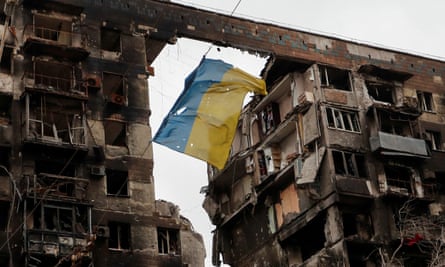



After Russian forces finally crushed Ukrainian resistance last May, they set about putting their stamp on Mariupol, erasing evidence of the recent atrocities and of past Ukrainian history in the city.

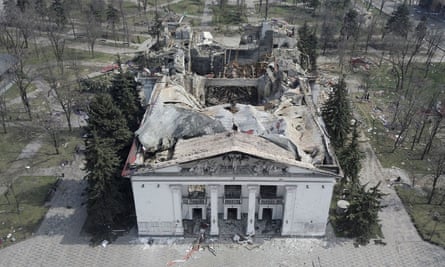

A year on from the invasion of Ukraine, the Guardian tells the story of Mariupol – perhaps the bloodiest and most shocking chapter of Russia’s brutal war.
Invasion
Mariupol greets the new year, 2022, in a relaxed mood. When a strong gust of wind blows over the city Christmas tree, sending its vast illuminated branches crashing to the ground, a few suspicious types whisper that it could be a bad omen for the year ahead.
But most people pay little heed to the crescendo of chatter about Vladimir Putin’s nefarious plans for Ukraine.
They are used to the idea of war here, after the events of 2014 when Russian proxies seized neighbouring Donetsk and briefly controlled Mariupol, too. The frontline, just outside the city, has hardly moved for years. Occasional military skirmishes are a fact of life, but the idea of a full-scale invasion seems fanciful.
So for the first seven weeks of the year, life goes on more or less as normal. People huddle in cafes smoking shisha on cold evenings; teenagers giggle as they slip on the ice rink behind the drama theatre. At a nearby restaurant one Saturday night, a group of women dance to a vocalist singing in Russian and English; their husbands remain seated, nursing beers.
A few people do become uneasy and clean out their basements, equipping them as bomb shelters. They stock up on tinned food. Often, their friends tease them for such eccentric behaviour.
And then, in the early hours of 24 February, it begins.
Around 5am, calls go out to the chiefs of police and other municipal services, announcing that military hostilities have begun and ordering them into their offices. Most of them are already awake, roused by the sound of Russian artillery.
At 11 in the morning, the mayor, Vadym Boychenko, convenes a press conference. Already, three civilians are dead and six injured, he says. The mood in the room is tense, but Boychenko assures the few journalists present that officials and key infrastructure workers are still working, and life will carry on.
“Don’t panic. We are ready to fight for Mariupol and Ukraine,” says the mayor.
He and most of his team will flee the city three days later.

On those first few days, the fighting is limited to the outskirts of the city. Wounded soldiers arrive at the hospitals from the front, and hundreds of volunteers show up to donate blood.
There are long queues at ATMs and petrol stations, but public transport is still running, and some people stoically continue as if everything is normal, heading for work.
At the train station, a young couple hurries along the platform dragging suitcases and cradling a cat. Tearful parents bundle their children on to evacuation trains heading for Kyiv. But the trains leave half empty. By the time most people realise what is coming, it will be too late to leave.
The city is well defended from the east, where everyone expected the Russians to launch an attack. But there has been no preparation for an invasion from the west. Russian troops pour across the narrow isthmus from Crimea towards Mariupol, and within a few days, the city is encircled.
Almost immediately, the Russians hit the electricity, water and gas supplies. People melt snow for water, and cook outside over open flames. Phone reception disappears, creating an information vacuum. The last shops close their doors, soon to be looted by people desperate for food.
As the fighting becomes more intense, people drag mattresses into the stairwells of their apartment blocks, or move into their dark and freezing basements. Some people are too old or too frail to move. Most of them will not survive.
At Hospital Number One, on the eastern side of the city, Serhiy Mudryi, a traumatologist, arrives for a two-day shift on 28 February. It is too dangerous to move around the city, so Mudryi sleeps at the hospital. His shift will end up lasting 40 days; he leaves only once, to collect his family and bring them back to the hospital, giving them beds in an empty ward.
Most of the other doctors flee, and soon there is just a skeleton team remaining at the hospital: Mudryi, two surgeons, an anaesthesiologist and a couple of nurses.
Arrivals are frequent, both soldiers and civilians. Before long, the ambulances stop running and patients arrive in private cars, driven by relatives frantic with worry. It takes a lot to shock a traumatologist with two decades of experience, but the minced flesh and crushed bodies Mudryi is seeing every day turn his stomach.
The doctors do not have the time for the complicated operations required to save limbs. “Post-operation, wounds require lots of care, there is a huge risk of infection and gangrene, and then dying from it,” Mudryi explains to patients. Now, whenever there is a serious injury, the doctors amputate. The patient will lose an arm or a leg but have more chance of staying alive.
As the fighting shifts into the suburbs and more buildings come under fire, many people who live close to the hospital arrive and move into the hospital basements. One 92-year-old woman tells Mudryi she has come because she remembers hiding in the same place during the second world war.
The hope that hospitals will be spared the worst of the war turns out to be naive. Across town, a maternity ward is shelled, and photographs of a bloodied, heavily pregnant woman scrambling through the rubble shock the world. Russian officials suggest the woman is an actor.
Soon after, in the Turkish resort town of Antalya, the Russian and Ukrainian foreign ministers meet, the highest-level discussion since the war started. The two men discuss Mariupol more than anything else.
Russia’s Sergei Lavrov looks his Ukrainian counterpart Dmytro Kuleba in the eye, and tells him the maternity ward was filled with Ukrainian fighters, not pregnant women.
“Unfortunately, I can confirm that the Russian leadership, including minister Lavrov, live in their own reality,” says Kuleba.
The talks break up after 90 minutes, with no agreement on anything.

Siege
With no mobile reception in the city, rumours spread of ceasefires and of evacuation corridors, but there is no verified information. Will the Ukrainian forces let them out? Will the Russians shoot at them on the way? Are Russian troops already in Kyiv? Nobody knows for sure.
The fighting intensifies to a level where dashing to a well or stream for a bucket of water carries a serious risk of being a one-way mission. During breaks in the shelling, people dig shallow graves and bury the dead on the spot.
In one central apartment block, a group of men dash out in mid-March to bury several older women, killed while cooking over an open fire in a courtyard. It is a scene repeated across the city.
“I knew those old women all my life. They sat outside the apartment block on the benches, chatting away, passing the time. And then you have to close the eyes of those women and bury them in their own courtyard,” recalls Vitaly, one of the impromptu gravediggers.
Elsewhere in Ukraine, people desperately try to contact relatives in Mariupol to find out if they are still alive. “This phone number is out of coverage,” is invariably the automated response. People begin to have nightmares about the phrase.
Every few days, there might be a fleeting moment when a bar of reception appears and people’s telephones light up with messages. Sometimes, the delayed news brings a wave of overwhelming relief at a sign of life, on other occasions it brings confirmation of the worst fears.
As time goes by, some people become angry and hysterical, as it dawns on them that there is no safe way out of the city and they may die in their basements, from the cold, the hunger or the bombs.
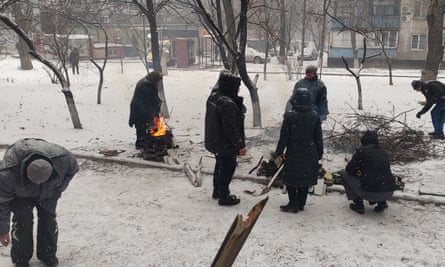
Maryna Puhachova, an activist and lawyer, develops a morning ritual to help her stay calm: soon after dawn, she goes outside with the neighbours, collects some snow and boils it over a flame to make coffee.
A bit later, she sits by the window, the only source of light in her apartment, and applies her makeup. The booms are relentless, and next to the window is the most dangerous place to be, but she finds the routine to be soothing.
Some people in the neighbouring block see her doing it and suspect she may have gone mad. But then they start doing it too, and before long a morning ritual is established in which several women sit at their windows, wave to each other and do their makeup. It is a small moment of humanity that keeps them going.
During the days, when the shelling quietens, Puhachova speeds across town to a distribution point, where volunteers collect food aid and drive it to places where they know there are large concentrations of people sheltering in cellars.
Puhachova has worked for many years in the villages around Mariupol, for an organisation offering legal and psychological support to people living close to the front line. She is used to operating under pressure. But with each day, the runs across town get hairier. She sees burning cars, and corpses gnawed at by stray dogs.
She witnesses acts of grim selfishness, such as people trying to sell looted supplies for a profit, but also gestures of remarkable bravery and kindness, like those who give away their last food and medicines to people in greater need.
She tries her hardest to put on a brave face when she visits the basements to deliver food and sees the desperation in people’s faces. She can sense that people appear reassured by the sight of someone who remains strong and cheerful, at least on the outside.
Theatre strike
As more residential blocks sustain hits, and with evacuation routes out of the city closed off, many people congregate at a series of public shelters. Perhaps the largest is at the drama theatre, where more than 1,000 people take refuge. In front of the colonnaded building, someone spells out the word DETI – children – in giant Russian letters.
On 11 March, Oleksandr Khodzhava, a steelworker, arrives at the theatre with his parents, wife and two young daughters. Heavy shelling near their apartment block has collapsed the plaster ceiling of their basement, and the neighbours mention that the drama theatre has become a refugee shelter, and thus should be spared from strikes.
On arrival, the family find a place to sleep on the cold floor of a costume room, beside sewing machines and bits of cloth. They receive meagre rations three times per day: hot water for breakfast, soup for lunch, and a biscuit for dinner.
Early in the morning on 16 March, they relocate to the cellar, a theatre control room full of electronics, thinking it will be safer there. The floor is covered with soft padding ripped from seats and armchairs.
Oleksandr goes to help with food preparations, while his wife takes their youngest daughter back up to the costume room, to clean their former quarters. Oleksandr’s parents, Serhiy and Iryna, stay down in the basement.
Somewhere in the distance, they hear the faint noise of a plane’s engines. Shortly after, there is a flash and a huge explosion.
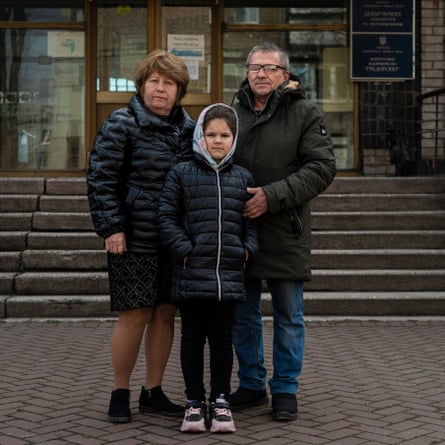
The blast throws Serhiy 3 metres across the room and rips off the cellar doors. Everything is covered in chalky dust; thick smoke hangs in the air. He struggles to his feet after freeing himself and clambers his way out of the cellar. The floor is awash with blood, and through the smoke he sees two men pull another man from the rubble, his boots attached to his legs only by bloodied skin, all the bone gone.
In the landing area by the stairs, Serhiy finds his wife and their eldest granddaughter, but Oleksandr has been crushed under rubble. Oleksandr’s wife, Anastasia, and their young daughter, Karolina, are also missing in the costume room. Although dazed and shocked, looking at the ruins Serhiy knows for sure there is no chance any of the three survived.
Serhiy and his wife, holding their surviving granddaughter, Valeriya, by the hand, wander in shock in the streets around the theatre, coughing from the dust and unsure what to do.
After some time, a family in a car about to embark on the risky journey out of Mariupol hears the wails of the newly orphaned Valeriya, and offers the trio a lift. They make it to Ukrainian-controlled territory, where they must start a new life equipped with no possessions to speak of and a devastating sense of loss.
Russia first claims the theatre was filled with Ukrainian troops. Later, it changes its story, insisting the theatre was blown up by Ukrainian forces as a “provocation”. The evidence, however, points to a Russian airstrike.
The Associated Press estimates that 600 people died in the attack.

Collapse
The last vestiges of Ukrainian authority in Mariupol fade rapidly. On 15 March a decision is made that policing is no longer possible. Around half of the prewar police force is still in the city, many of them sleeping on the floor in barricaded police stations and heading out on patrol when they can. Now, they have a decision to make.
Some join the army, others attempt to leave the city on routes dotted with numerous checkpoints, where Russian soldiers are on the lookout for anyone pro-Ukrainian. Soon, the Russians will set up “filtration” centres to question anyone leaving Mariupol, involving strip searches and lengthy questioning, but for now, the process is still ad hoc.
At one checkpoint, Artem Kisko, the deputy head of the regional police, tells a speedily invented story that he is a coffee salesman who has lost his documents. The soldiers quickly tire of the long yarn about coffee supplies. They let him through.
Another Mariupol police officer is recognised at a checkpoint by a former colleague from Donetsk, who in 2014 took the side of the Russians and now serves in the army of the so-called Donetsk People’s Republic.
The soldier recognises his old colleague immediately, and initially issues threats. But then, just as he is turning to tell his superiors he has caught a Ukrainian cop, something changes in his eyes. “Go,” he whispers, and waves the car through the checkpoint. The police officer drives on, shaken, and reaches Ukrainian-held territory safely.
Lives and fates turn on such split-second moments. On many other occasions, Ukrainian police, officials or activists are identified and hauled off to Russian basements for interrogation or worse.
The International Committee of the Red Cross pushes Kyiv and Moscow to create a humanitarian corridor to let civilians out of Mariupol in a safe and orderly way, but there is no agreement.
Many people try to run the gauntlet anyway, driving across the frontlines and braving the multiple Russian checkpoints. There is no petrol left in the city now, so seats in vehicles with enough juice to make the journey are bartered and pleaded over. In Zaporizhzhia, cars arriving from Mariupol are easy to spot: passengers packed inside like sardines and the windows often shot out.
Most people remain in the city, trapped without either the information or the transport to make their way out. Day by day, the fighting gets more intense and the humanitarian situation worsens.
At Hospital Number One, the traumatologist Mudryi and the two surgeons now work by natural light, using the generator only if there is an absolute medical need for light or electronic equipment.
In the basements, the civilians joke darkly that it’s a celebratory moment when a seriously wounded patient arrives. The generator is turned on and there is the opportunity to charge phones or boil a kettle.
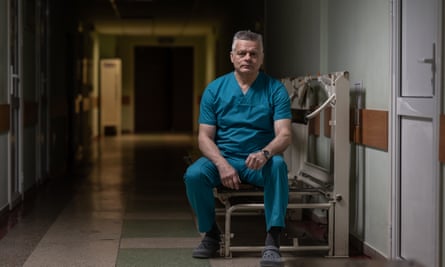
The doctors use tiny makeshift oil lamps to provide weak light when the day is over. Mudryi is reminded of the memoirs of Nikolai Pirogov, the celebrated Russian physician who performed field surgery during the Crimean war. In the space of a month, he has moved from the 21st century to the 19th.
The small team is forced to perform operations for which they have no experience. A heavily pregnant woman arrives wounded, and they amputate a leg. She survives, but miscarries.
Many people cannot be saved, and the morgue is soon overflowing. Explosions shatter most of the hospital windows. Mudryi and his family pull their mattresses into the corridor, to sleep more safely.
One day in late March, the remaining anaesthesiologist, Oleksandr Zhuk, attempts a short drive outside the hospital to return a patient to another shelter, but on the return journey his car is shot up and he is hit multiple times. He makes it back but only just, his car slamming into the hospital building with Zhuk slumped over the wheel and losing blood fast.
Before losing consciousness, Zhuk tells the other doctors what sedation to give him and whispers his blood group. Mudryi and the surgeons dress the wounds and perform a transfusion, in semi-darkness, using the blood of someone in the cellar with a matching group. Somehow, Zhuk pulls through.
With every passing day, the fighting gets closer, and the hospital becomes more dangerous. At the end of March, they decide they can no longer use the generator; it is as noisy as a tank and Mudryi fears it could draw attention and lead to the hospital being targeted.
They tell 10 remaining patients who require regular kidney dialysis that the machines will not be switched on again. Six of the 10 struggle out of bed and depart, on foot, towards the frontline, hoping they might survive the walk and reach a hospital in Russian-occupied Donetsk in time to receive dialysis. Four are too weak to move, and stay behind in their beds to die.
By early April, the area of the hospital is the scene of close-quarter street fighting. For three days, Mudryi and the other doctors are confined to the cellar, while 40 patients too ill to move are left in beds in the ward.
On 6 April, Russian soldiers peer into the basement, announcing they now control the territory and there will be an evacuation. When Mudryi emerges, the hospital buildings have taken multiple hits. He never finds out whether his patients survived or were burned alive.
By the end of the fighting, according to one estimate, 82 out of 106 hospitals and other healthcare facilities in Mariupol have been destroyed or damaged.
Azovstal
The Russians are closing in on the centre of Mariupol from all sides. In the middle of April, the army leadership orders all remaining units of Ukrainian troops defending the city to regroup at Azovstal, the vast steel plant that dominates the Mariupol skyline.
Azovstal, constructed in 1933, is a city inside a city, a sprawling industrial park with dozens of cavernous steel hangars. Underground, there is a network of basements, some of which were fitted out as shelters after the 2014 conflict.
The plant serves as the makeshift headquarters of the Azov regiment, a Ukrainian national guard unit that has grown out of a volunteer force with links to the far right, which first defended the city in 2014. Azov are now leading the defence of Mariupol, insisting they have shed their previous dubious politics and rapidly becoming Ukrainian heroes.
Other units fight their way through to the plant. Sviatoslav Yermonov, a former cop who signed up in March, arrives in a convoy from the port area that comes under heavy fire en route. About a third of them are killed on the way, he estimates. Another group claims to have made it through by daubing their vehicles with Russian Z symbols and speeding through enemy lines.

The Azov commanders assign Yermonov and his men a position on the factory perimeter. They work in shifts, resting in the basements when back from their defensive positions.
Two of the basements are packed with civilians, plant employees and their families, whom the factory director invited to take refuge when the hostilities started, not expecting that the Ukrainian military would also see the warren of tunnels as the perfect place for a last stand against the Russians.
Conditions steadily worsen in all the basements. Some areas are so dusty and dirty that the soldiers find their clothes and exposed skin are quickly covered in a thick layer of grime.
Food is rationed to one meal a day; on their brief breaks, Yermonov and his team hunt for leftover provisions in the bunkers. There is plenty of black tea, left by the steelworkers, but finding sugar is a rare success and cause for celebration.

The Russians fly drones to monitor movements above ground, then send in aviation once they clock a potential position. “At first the planes came in twos, and then in fours. They dropped bombs on the factory buildings, on the bunkers,” Yermonov recalls later.
The steel and concrete structures are surprisingly sturdy, and Yermonov’s hangar remains structurally sound for two weeks, despite heavy bombardment.


By the end of April, Azovstal has taken on an epic symbolism for both sides. For the Russians, the retreat from Kyiv in late March has left the Kremlin’s initial battle plans in tatters, and Mariupol becomes important as a tangible gain, even if they have to destroy the city to conquer it. For the Ukrainians, the last stand at Azovstal becomes a David and Goliath tale of heroic resistance.
The Russians drop huge FAB bombs, which smash through the ground and reach the basements, the blast impact throwing one wall against another and crushing those in between.
Dmytro Kozatsky, a press officer for the Azov regiment, wakes one night with a start, thinking he has fallen out of bed. He notices the bunker is much colder than usual. When he stands up, he sees that much of the wall has gone and he is standing partially in the open air.

Putting on a jacket and flip-flops, he turns and sees a fellow soldier lying on the floor covered in blood, sighing his last breaths. Twelve people die in the attack.
As conditions become ever more unbearable, Ukrainian military intelligence plans a series of daring helicopter missions to bring supplies to the besieged plant. The pilots fly just a few metres from the ground and hope for the best. Not all of them return alive.
The small helicopters can hardly provide adequate resources for the 3,000 people still at the plant, but they do bring one gamechanging piece of equipment: Starlink devices that allow the Azovstal defenders to beam out photographs and video each evening. Kozatsky’s photographs of weak soldiers laid out with gruesome wounds resonate around the world.
Azovstal is now at the centre of international attention. The UN secretary general flies to Moscow to ask Vladimir Putin to open a corridor for the civilians at the plant to leave. Wives of the fighters travel to the Vatican to petition the pope.
Finally, on 1 May, the United Nations and the International Committee of the Red Cross facilitate an agreement between the two sides to secure the release of the civilians.
An ICRC team sleeps in a tent encampment outside the city and travels into the city to facilitate the release. One of them, Mariateresa Cacciapuoti, knows Mariupol well, having spent time there before the war. She is shocked at the level of destruction she sees on the ride into the city.
With a brief ceasefire in place, people slowly begin to emerge from a hole between slabs of collapsed concrete, where an airstrike had hit one of the bunkers. “They were physically and mentally distressed, they were so white, they had not seen the sun for weeks,” Cacciapuoti recalls later.
With the civilians gone, the Russians discuss storming the plant. Amid rumours of a surrender, many fighters inside discuss whether it might be better to fight to the very end, or embark on a suicidal break-out mission to storm Russian lines.
But on 16 May, after top-secret negotiations between emissaries of Kyiv and Moscow, Ukraine’s general staff orders the remaining Azovstal fighters to lay down their arms.
Over the next four days, a total of 2,439 fighters give themselves up to the Russian forces outside the plant, with the ICRC overseeing. They have months of captivity ahead of them. At 4pm on 20 May, the final group of Azovstal defenders, including Yermonov, leave the plant.
After more than 80 days of fighting, the Russians have won the battle for Mariupol.

Burials
The Russians celebrate victory in the devastated husk of what was once a vibrant city. Its people are starving, there is no water or electricity, and humanitarian organisations warn of a possible cholera outbreak.
The city is an open cemetery, with thousands of shallow graves in the courtyards of apartment blocks. As rescue teams go door to door, they find that often the elderly or immobile starved to death in their apartments.
Even the propagandists on Russian television admit the situation is dire. “Residents of destroyed Mariupol are cooking broth from pigeons on bonfires in their courtyard,” the NTV channel tells its viewers in late May. But the culprits for the devastation are presented as “Ukrainian Nazis”, not the Russian army.
With the return of mobile communications and the end of fighting, there is a rush of activity among those who fled to find out information about their loved ones, and to attempt dignified burials of the dead where possible.

One woman pays $100 to Chechen forces to retrieve the body of her son from under a pile of rubble, where he has lain for a month. She pays another $100 to ensure he gets his own grave at the Starokrymske cemetery, a short drive outside town, which is becoming one of the central points for burying the victims of the siege.
The vast cemetery, overlooking the city skyline and the glimmering Sea of Azov, contains fields of ornate monuments, crosses and tombstones from years past that stretch out into the distance.
In June, digging begins at the far end of the cemetery, with multiple new trenches each holding around 25 coffins. Some of them have names and dates of birth; most are just wooden signs marked with numbers.
By December, the number of makeshift graves is already approaching 4,000, representing several months of gruesome work for the cemetery employees.
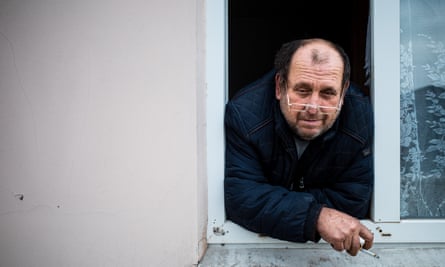
“I don’t know how many I’ve buried. But it’s many. Very many,” says Oleksandr, a soft-spoken gravedigger, his arms leaning on the window frame of the cemetery’s administrative building.
Oleksandr has worked as a gravedigger for 13 years, but nothing prepared him for the past few months, during which burned bodies and mutilated limbs have been a daily sight.
“Sometimes we got boxes with body parts from whole families thrown together – parents and children all in one,” he says, shaking his head slowly and pulling on a cigarette.
Overhead, a flock of ravens circles, filling the quiet, ghostly churchyard with the sound of loud, gurgling croaks.
“You see it with your own eyes, but you don’t know what to think, or how to process it.”

Reconstruction
The Kremlin appoints St Petersburg, and the far eastern city of Khabarovsk, as “patron” cities to oversee the reconstruction of Mariupol, and sends in scores of officials to lead the reconstruction.
In October, Russian outlet the Insider publishes a glossy 32-page document commissioned by Russia’s construction ministry. It is a plan for the rebirth of Mariupol, complete with colourful slides detailing building regulations, public transport routes and bike lanes.
Russian firms recruit thousands of central Asian labour migrants to rebuild the city.
Abdulloh, a 24-year-old carpenter from Tajikistan, arrives in Mariupol in mid-December on a long bus journey from Moscow, where he previously worked on construction sites, together with others from Tajikistan and Kyrgyzstan.
The men live in a half-destroyed college dormitory, and work long hours renovating various buildings. There are about 300 workers from Tajikistan at Abdulloh’s construction site alone.
He is surprised to hear that his presence in Mariupol would be considered a border violation by Ukrainian authorities. “We were told that this city belongs to Russia and that is all,” he says. He is more concerned that the generous salary he was promised has been paid only partially.
Russian news bulletins are filled with tales of happy residents receiving the keys to apartments in newly built blocks. But despite the intensive rebuilding efforts, it will be a very long time before any semblance of normality comes to Mariupol.
In the old town, a ramshackle but charming collection of old buildings nestled on a slope that descends towards the Sea of Azov, every wall is pockmarked with bullet holes and shrapnel damage, or larger craters from rockets and grenades. The streets are desolate, save for an occasional passing car.
One afternoon in December, a rare sight in the eerie quiet: an elderly woman carrying a grocery bag and a jug of water. Behind her, three dogs follow with playful devotion.
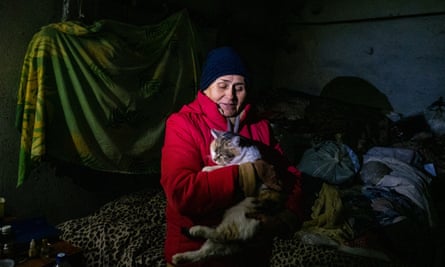
During the siege, 75-year-old Angela shared the basement of her block with 34 neighbours. Now, they have all gone. She alone stayed, and has taken it upon herself to care for the numerous stray dogs and cats left behind.
Her top-floor apartment is damp, windowless and icily cold. She has covered most of her furniture with plastic and tarpaulin, fighting a losing battle against mould and rot as the roof leaks relentlessly.
The kitchen walls still bear the evidence of the time a sniper on an opposing rooftop mistook her for a soldier and sprayed bullets through her window, as she stood in her kitchen. Miraculously, she survived with nothing worse than a grazed heel.
With the apartment uninhabitable, she still lives in the concrete basement, and has done her best to make it cosy: there is a leopard-print blanket on the makeshift bed and flashing Christmas lights strung over the doorway. The thermometer by the bed shows 4C.
“It was a beautiful city, with a good economy,” she says, remembering the past of the place she has called home for most of her seven decades.
“Maybe one day it will return to its former glory, but I might not be alive to see it.”
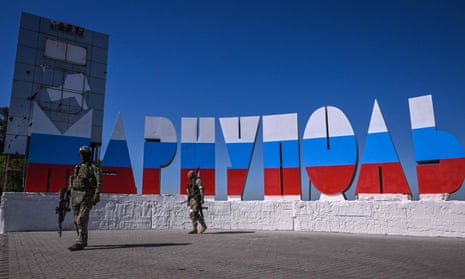
Russification
Along with reconstruction comes Russification. Symbols of Ukrainian rule are swiftly erased, starting with the large sign welcoming visitors to Mariupol, repainted in the red, white and blue of the Russian flag.
Streets and squares have their Soviet names restored. Omnipresent billboards and posters with the symbol “Z” portray the Russian occupiers as liberators.
For those who have working televisions, the programming is switched to Russian; internet traffic is also routed through Russian servers and access to many Ukrainian sites blocked.
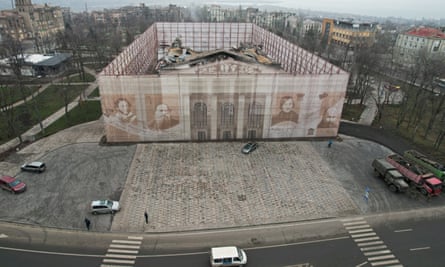
The idea is to repeat the experience of Grozny, the capital of Chechnya. Bombed to ruins by Putin’s troops at the very beginning of his reign over Russia, it was later rebuilt as a glittering metropolis using extensive subsidies from Moscow. Its main avenue was renamed in Putin’s honour and memories of the long history of Chechen resistance against Russia were suppressed.
In Mariupol, too, the horrors of the past – both recent and more distant – are to be forgotten. Russian administrators destroy Mariupol’s monument to the Holodomor, the artificial famine visited on Ukraine by Stalin’s regime in the 1930s.
In another part of the city, they erect a monument to Alexander Nevsky, a 13th-century prince. The governor of St Petersburg, in Mariupol to open the monument, claims Nevsky defended medieval Rus against “enemies who came from the same countries Russia is fighting today”.
Teachers in the city are forced to sign a document certifying their willingness to switch to teaching the Russian school curriculum. It features a Kremlin-approved version of history which casts doubt on Ukraine’s sovereignty and history as an independent nation since 1991. Some teachers are sent to summer schools in Rostov or Moscow, where they undergo a retraining programme. Ukrainian education “must be corrected”, says Russia’s education minister Sergey Kravtsov.
Administrative offices open across the city, where local people can receive passports that turn them overnight from Ukrainians to Russians, in the eyes of the Kremlin at least. Thousands queue to receive them; after all, a Russian passport is required to receive a pension or register a business.
On 4 November, Russia’s national unity day, Putin describes Mariupol as an “ancient Russian city”. As evidence, the Russian president cites the “well-known” fact that Peter the Great founded his first naval flotilla there in the early 18th century. The claim is entirely fabricated.
“Putin’s grasp of history is completely ludicrous,” says Vadym Korobka, a history professor at Mariupol State University, with a bittersweet chuckle.

Local support
There has always been a pro-Russian contingent in Mariupol, though after 2014 it dwindled as investment from Kyiv improved life for many in the city. But some locals are still receptive to Russian messaging and blame the recent months of misery on Ukraine.
Korobka, the historian, recalls sheltering in the basement of his apartment block during the siege and hearing some of his neighbours call the Ukrainian defenders of Mariupol “Nazis”, and insist that Russian forces would never shell a residential area, even as they were doing so at that very moment.
Now the Russians are in control, they co-opt local supporters and opportunists to help spread this narrative. Among them is Andriy Kior, a 52-year-old former spokesperson for Mariupol city council, who launches the Voice of Mariupol, a new pro-Russian newspaper.
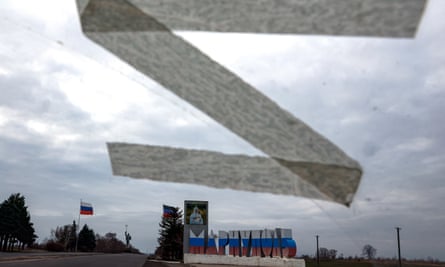
Before the invasion, in an interview at his apartment, Kior spoke of his love for Ukraine’s natural beauty and described Russia as Ukraine’s “main opponent”.
The change of guard in the city prompts a remarkable turnaround in his views.
“People are seeing the huge opportunities that Russia is giving them,” he claims in a telephone interview a year later, with the zeal of a convert. “The city is being restored at an incredible pace, all thanks to Russia.”

Darya, a 24-year-old student who left Mariupol in the summer, returns to the city in January, to care for family members and to be close to the grave of her boyfriend. She is amazed to find many people full of praise for Moscow.
“They are grateful for the help they receive, forgetting or ignoring that Russia was the one who took it all away from us. It blows my mind,” she says, mournfully.

Darya soon realises she does not have the emotional energy for these conversations. She learns how to discern a person’s political views in a few moments. “It is the way they talk, look at you, little things give it away. You learn to only voice your opinions with those you know you can trust. Otherwise, you keep your thoughts to yourself.”
As she walks among the ruins, everywhere she looks Darya sees the Russian propaganda posters, the paint-daubed Z symbols and the flags of the so-called Donetsk People’s Republic.
Once in a while, she sees a different kind of symbol: “Glory to the Ukrainian Army” splashed in paint on a wall, or a poster announcing that “Mariupol is Ukraine”. Sometimes, people have simply painted the letter ï, which exists in Ukrainian but not in Russian. It is a shorthand mode of resistance, and a glimmer of hope for those in the city who long for Kyiv’s return.
“I walk past and give it a smile. There isn’t much else we can do,” she says.

Mariupol in exile
An estimated 350,000 people have left Mariupol. Some are trying to start their lives anew in Russia, others are attempting to rebuild elsewhere in Ukraine. Many have become refugees in other countries, working hard to put the memories of the horrors they witnessed and the losses they sustained behind them.
Ukrainian authorities, pointing to the stunning recapture of Kherson in November, hope that before too long, they will similarly be able to liberate Mariupol.
For now, the city’s Ukrainian administration works in exile, from Kyiv, led by the mayor, Boychenko. During an interview, he gets visibly emotional when asked about the anger many feel about his decision to leave the city soon after the invasion. It was only from the safety of afar, he claims, that he could coordinate efforts to arrange evacuations.
Mariupol State University has temporarily relocated to Kyiv too, renovating a building there and with plans to start in-person tuition in September. Its rector, Mykola Trofymenko, claims only 10% of his teaching staff stayed in Mariupol and agreed to work for the duplicate version of the university, set up by the Russians.
“They will all have questions to answer later,” he says, darkly.
Ukrainian police units are monitoring news and social media posts from Mariupol, making a list of those cooperating with the Russians. Soon, they hope, Ukrainian authorities will be back in Mariupol, and hold these people responsible as traitors.
But in Mariupol, as in other territories occupied by Russia, this is a difficult and emotional topic on which there are many disagreements. Where is the line between cooperation to survive and collaboration? With every passing month of Russian rule, that potential future process becomes more fraught with difficulties.
Among those who left Mariupol, many do not plan to return unless Ukraine takes the city back; others have lost their homes and livelihoods and do not see any sense in returning to the city whatever happens.
In Warsaw, Kateryna Shukh, a Mariupol-born psychologist who managed to leave the city at the very start of the war, works with recent arrivals from Mariupol. In group therapy sessions, the women draw their feelings or work together to make different things. They practise breathing techniques. Sometimes everyone cries. It’s a good sign when that happens, says Shukh, because it means people feel safe enough to release their feelings.

She tells them that what they lived through will stay with them, and probably change them for ever, but that they can work on how it will influence them. “People need time to adapt. It’s a double process, to deal with what happened and to study how to live now,” she says.
Especially for the older refugees, the fact that they may never be able to return home can cause a state of mental paralysis and a refusal to accept reality. But Shukh’s personal experience gives her advice more credibility. “I was born in this city and lived my whole life there. I lost everything. So these women, I understand their feelings from the inside,” she says.
Shukh advises her clients not to subscribe to Telegram channels about Mariupol; not to scroll through footage from the occupied city. It brings emotions of anger and helplessness, neither of which are useful. But she admits that she isn’t always able to follow her own advice. The pull of home is too much, and she finds herself drawn to the images and videos.
Although the videos on the Telegram channels are shot in Mariupol, they do not seem like the place Shukh once called home. Even if Ukraine takes back Mariupol in the near future, the pain and trauma of the last year will leave an indelible mark on the city and its people.
“You understand that the place you spent your whole life will never be there again,” she says. “It’s gone.”







